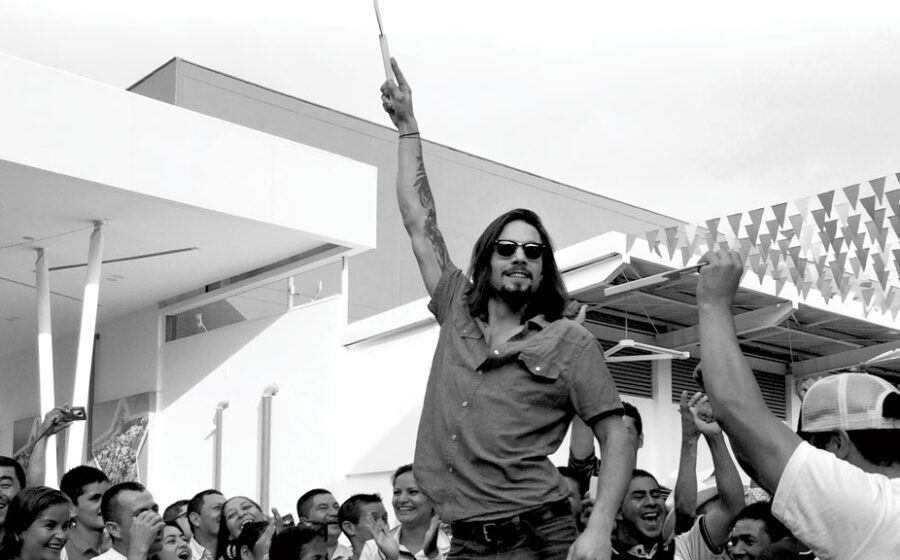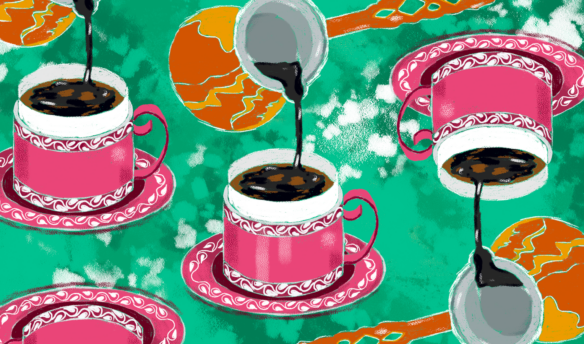[I]’m at an outdoor mall in Pitalito, Colombia, and it’s raining. I’m holding a Club Colombia Roja beer in my left hand, a paddle with the number eight in my right, and a gentleman in my row of seats is moments away from paying $31.50 per pound for a coffee grown some twenty miles down the road.
I’m in way over my head.
I speak what I would call survival Spanish, which is to say I can share my name, ask for directions, and fumble my way through a dinner menu—so long as pollo is an option. So on one hand, taking three flights to Pitalito to participate in a live auction for coffee seems like a leap of faith. My company is so green, just months into roasting and purchasing, trying to find coffees at attractive prices. Yet, at Huila Best Cup—a competition jointly organized by Café Imports and Colombia-based exporting company Banexport—the purpose is for green buyers to pay more than we ordinarily would.
The company I co-own, Summit Coffee, made the decision last June to start roasting our own beans so we can be more a part of the coffee process. Not only do I want to know our farmers, I want to shake their hands, hug them, know who’s cashing the checks I write. In the end, what brings me to this outdoor mall, sitting in the rain with twenty-two other green buyers from around the world, is their lives. Their lives, which have been dedicated to coffee, to providing for family, to improving, and then improving on that improvement.
I’m not alone in possessing that desire.
“As a micro-roaster, connecting directly with producers and pursuing direct trade can be difficult,” Eric Faust, owner of Duluth Coffee Company, told me. “What the Best of Huila and auction does is allows for small companies like mine to have the opportunity to make a direct connection and award a farmer a price for their coffee that shows our appreciation for their pursuit of quality. The structure of the competition allows us to work within our means.”
We in developed countries so often take for granted our situations, more specifically our food, and even more specifically our coffee. Most of us are at the end of the coffee process. Our cup is finite. It’s brewed, it’s enjoyed (ideally), and then, in a matter of minutes, it’s gone. That particular coffee’s life climaxes and bids farewell in our very drink.
What the Best of Huila and auction does is allows for small companies like mine to have the opportunity to make a direct connection and award a farmer a price for their coffee that shows our appreciation for their pursuit of quality.
Coffee companies I admire—Counter Culture and Blue Bottle, to name a couple—are tremendous at telling a story. Where was this coffee grown? Who picked it? What was its processing method? What does it look like on that farm? Furthermore, they provide media to bring that story to life, with pictures of the farmers and videos of the processing. Micro-roasters like us at Summit Coffee don’t have the wherewithal to travel from farm to farm, and so our storytelling of the coffee lifecycle often pales in comparison. But with events like Huila Best Cup, this doesn’t have to be the rule.
This, in essence, is what allowed me to come to the outdoor mall in Pitalito, in the rain. I’ve spent a week cupping and cupping, then cupping some more, to help select the best twelve crops in all of Huila. And now, these farmers and their families, and their friends and their families, surround us as we prepare to bid for the privilege to give their coffee a worthy end. Blessed are we to be the recipient of this labor, to be lucky enough to be at the end of the coffee lifecycle. A life that has spanned months and months, from hand to hand to hand to hand, from truck to boat to freight. To us. To our cup.
“The live auction was the most exciting thing I’ve seen in my coffee career,” said Clancy Rose, co-founder of Austin’s Wild Gift Coffee. “It was humbling to to be a part of something that has that much impact on producers and the community as a whole.”
Huila Best Cup gives me, and many buyers and roasters like me, a rare opportunity for reverence. I paid a premium for Jairo Quinones’ coffee from Nueve Zelandia, not just because it cupped at an eighty-nine. I paid that premium to Jairo because of a relationship. It’s an eleven-bag lot of coffee. But it’s also a true, eye-to-eye, direct trade relationship for Summit Coffee. Counter Culture and Blue Bottle loyaltsts look forward to Aida Batlle’s next harvest of Finca Kilimanjaro, and I want our customers to be excited, in 2017, when Jairo’s next crop hits our shelves.
And beyond Jairo, this opens our eyes to what it means to purchase coffee at origin. The thrill of catching the C-market on a down day is one thing. Buying a crop from a farm you’ve visited and from a farmer you’ve met is quite another.
As a retailer, I’ve always understood coffee as a relationship business—barista to customer. The goal now is to extend the relationship from farmer to customer, valuing that more than a price differential.
This is what brings me to an outdoor mall in Pitalito, Colombia, sitting in the rain.
—Brian Helfrich is the co-owner of Summit Coffee Company in Davidson, North Carolina.















